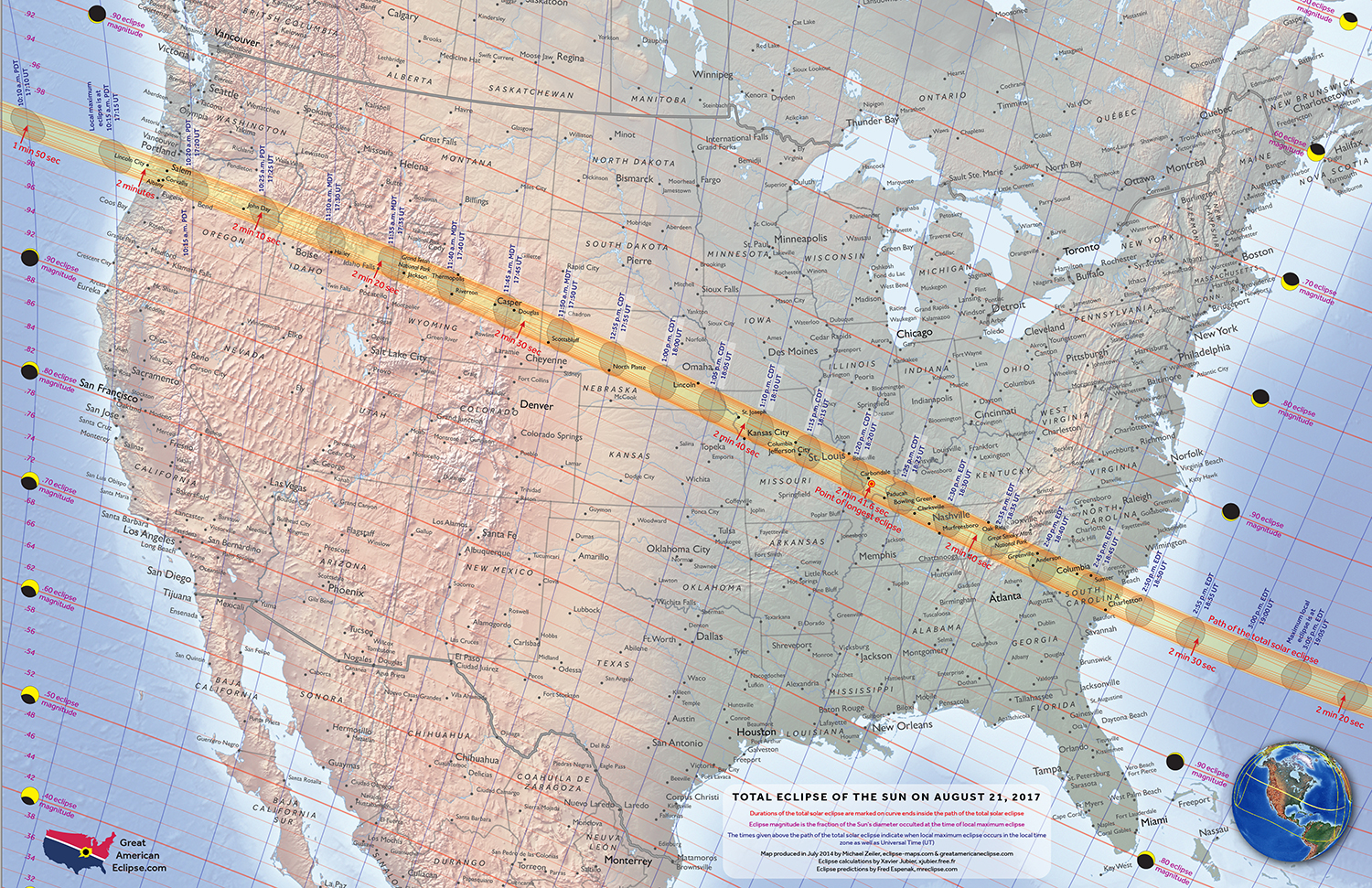TOTALITY AUGUST 21, 2017
The ‘Great American Eclipse’
The total solar eclipse of August 21, 2017 was referred to as the ‘Great American Eclipse’, as the path of totality crossed the whole of the US from Oregon to South Carolina, visible from 14 states. It was the first total eclipse visible from the U.S. mainland since 1979.
In the years leading up to this eclipse, my White Paper on Community Eclipse Planning was distributed as a resource to communities across the path of totality. I was approached by around 30 communities across the path to provide online consultations and guidance on how to prepare their community, and make the most of this once-in-a-lifetime opportunity for their community. These consultations provided much-needed information regarding the time-line of eclipse planning, which helped inform eclipse planning for future eclipses, such as in 2024. See PLANNING for more details.
I also did detailed planning for several communities in Nebraska, and visited on several occasions to provide more intensive on-the-ground support. Much of this work appeared in the local, national and international media.
As so many resources were made available for this total eclipse, this page will remain as an information archive.

For the first time since 1979, millions of Americans experienced this amazing event without having to travel abroad. For the 12 million people living within the path of totality, all they had to do was step outside and look up.
The path of totality for this total solar eclipse started in the north Pacific Ocean, and then made landfall across the central part of North America, crossing the states of Oregon, Idaho, Montana, Wyoming, Nebraska, Iowa, Kansas, Missouri, Illinois, Kentucky, Tennessee, North Carolina, Georgia and South Carolina. The moon’s shadow then continued out into the Atlantic Ocean, with a maximum width of 70 miles. The maximum duration of this eclipse was 2 minutes and 45 seconds in western Kentucky.
This was my 10th total solar eclipse, and marked my first eclipse saros. I again partnered with The Independent Traveller and led a small tour group of 33 international eclipse chasers. We were privileged to view from one of the most stunning locations across the whole path – Teton Village in Grand Teton National Park, Wyoming. This tour was sold out, and we had clear skies and the most perfect viewing experience.
The visualisations below show the Moon’s central shadow touching down on the U.S. mainland. The central shadow formed the path of totality, where the total solar eclipse was visible. You must be in the path of totality to experience a total eclipse.
This animation closely follows the Moon’s umbra shadow as it passes over the United States during the August 21, 2017, total solar eclipse. Credit: Ernie Wright (USRA): Lead Visualizer Scientific Visualization Studio. The Blue Marble data is courtesy of Reto Stockli (NASA/GSFC).
The umbral and penumbral shadow cones travel across the surface of the Earth during the August 21, 2017, total solar eclipse. Credit: Ernie Wright (USRA): Lead Visualizer. Genna Duberstein (USRA): Producer. NASA’s Scientific Visualization Studio.
HELPFUL LINKS
The following are links to external sites and are my recommendations for further information about the 2017 total eclipse. Many of the people behind these websites are passionate eclipse chasers who spend their time (just like I do) developing resources for other to use in their eclipse planning. Click on the links below – these people have also updated to incorporate future eclipses too.
GreatAmericanEclipse.com is an excellent site with detailed information and superb eclipse maps. Run by eclipse chaser Michael Zeiler, a professional cartographer.
Eclipsophile.com pulls together real-time satellite images and computer models that will facilitate finding clear skies on eclipse day – an essential resource. Run by eclipse chaser Jay Anderson, a Canadian meteorologist.
Eclipsewise.com is the authoritative source for lunar and solar eclipse predictions and information. Run by eclipse chaser Fred Espenak, a retired NASA astrophysicist also known as ‘Mr Eclipse’.
SolarEclipsesGoogleMaps is a feature-laden interactive GoogleMap that allows for detailed information across the path of totality for past and future eclipses. Run by eclipse chaser Xavier Jubier, a French IT specialist.
www.eclipse2017.org is a very comprehensive site that focuses on the next total eclipse on August 21, 2017. Run by eclipse chaser Dan McGlaun.
The official eye safety guidance endorsed by the American Astronomical Society and NASA can be found on this site. This is THE authoritative guidance, anything that contradicts this information is wrong.
Several sites are collating eclipse events. This thorough listing by the AAS includes communities within and outside of the path of totality, as well as eclipse tours and conferences.
This site shows how you can be involved in scientific observations, experiments and projects that you can do yourself, or be part of across the path of totality. Coordinated by NASA.
The best advice for your first total eclipse is to simply observe it. But if you want to know about basic smartphone photography, then start here with NASA at Eclipse2017.nasa.gov
